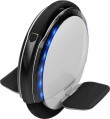Range
The average distance that can be driven on a single battery charge. Usually, the range is indicated with some overestimation — based on a low (optimal from the point of view of energy consumption) speed, uniform movement on a flat surface, etc. Therefore, the actual battery life may be somewhat less. Nevertheless, this parameter is quite suitable for comparing different models with each other.
Thanks to the development of technology, the range in modern self-balancing vehicles can reach
several tens of kilometers.
Max. speed
The maximum speed that the hoverboard is capable of reaching: on a flat surface, with a full battery charge and an average rider weight. The same parameter is also the maximum safe speed allowed when using this model; in theory, it is possible to accelerate even faster (for example, from a mountain), but this is fraught with breakdown, accident and injury, and therefore is not recommended at all.
Most modern models have a maximum speed of up to 20 km/h, and in “high-speed” vehicles this figure can exceed 30 km/h. Note that a fall from a hoverboard, even at a speed of 10 – 15 km/h, is fraught with serious injuries. Therefore, protective gear is highly recommended.
Max. climb angle
The maximum angle of inclination of the surface at which the vehicle can normally drive up or down (in some models, this parameter is indicated only for one direction, for example, up).
This parameter characterizes the ability of the device to overcome ups and downs. In modern models, it can reach 45 °. At the same time, note that the ability to cope with large angles requires not only powerful motors, but also appropriate design features (in particular, so that the protective cover does not scrape the ground); and for the descent, the second is even more important than the first. Therefore, when choosing a model for frequent driving on slopes, you should pay attention not only to power, but also to the angle of inclination directly stated in the specs.
Also note that at a high load (approaching the maximum), the efficiency of overcoming climbs may decrease. On the other hand, some manufacturers indicate the angle of inclination at the maximum load, and clarify that the light weight of the rider allows you to overcome steeper climbs than originally stated.
Battery capacity
Battery capacity of the device in milliamp-hours (mAh)
This parameter characterizes the amount of energy that the battery can store. The
higher the number the more energy the battery stores, respectively, the greater the range (see above) and the more time it will take to charge. However, mAh is a popular, but not very reliable unit of power measurement: the actual amount of stored energy depends not only on the “milliamp hours”, but also on the battery voltage (and it can vary greatly in different models). The actual battery life strongly depends on the power consumption of the unit (determined primarily by engine power). This means that only models with similar performance characteristics and the same battery voltage can be compared with each other in this indicator. And when choosing, it’s easier to focus on more practical indicators — first of all, the range.
Battery capacity
The battery capacity of the device in watt-hours (Wh).
In general, capacity shows the amount of energy that a battery can store. The higher the number, the more energy the battery stores, respectively, the greater the range (see above) and the more time it will take to charge. Note that although watt-hours are used to designate power much less frequently than milliamp-hours (see above), this designation is more reliable, because when evaluating capacity, in this case, the battery voltage is also taken into account (as opposed to counting in mAh). This makes it easy to compare batteries of different voltages. At the same time, do not forget that the energy consumption of different models can also be different, and battery life is easier to evaluate by the directly claimed range.
Full charge time
The time required to fully charge the battery from zero to full capacity. This parameter allows you to estimate how long the breaks should be for a full replenishment of the energy supply. Reducing the charging time makes the use of the device more convenient, but it is achieved through special technologies, which, usually, are not cheap.

